
UFO's.
UFO's are real, but it is illogical to assume they could only be alien spaceships. Aliens shouldn't be the default explanation for strange optical objects in the sky. Keeping an open mind, we need to consider all the other possibilities.
Ask yourself, "Who sees them?" I find it really interesting that professional and amateur astronomers don't report UFO's. Astronomers are experienced, knowledgeable sky observers. They have collectively spent millions of hours staring into the night sky. So why don't we get UFO reports from this group on a regular basis? They take thousands and thousands of high definition photos of the night sky. Why don't all the astronomy magazines have photos of flying saucers?
Because of my interest in astronomy and the universe, I am certain there are other civilizations out there on earth-like planets, far, far away. So what could these lights in the sky be?
Navy pilots began spotting strange, fast-moving objects after their jets' radar systems were upgraded. This suggests the sightings could easily stem from a software bug or instrument issue, typical of upgraded operating systems. Such reasoning is upheld by the tendency of UFOs to manifest as blobs or blurs on the displays of advanced instruments rather than as crisply defined objects. The most probable explanation is that phantoms are created by artifacts or glitches in the imaging systems, and artifacts or glitches in the software.
Another possibility is that the pilots are seeing advanced reconnaissance craft designed to fly faster than a human occupant could withstand. These are currently in use by other countries as well, to spy on the US.
There is private funding available for UFO research, silicon valley entrepreneurs offering over 100 million dollars to fund it. So of course some researchers have gone after that funding. Many of these researchers have no background in science but a long interest in UFO’s.
So why don't astronomers regularly report UFO's? Astronomers are are more likely to recognize what they are actually seeing, and a UFO quickly becomes an IFO (identified object). An astronomer is more likely to be acquainted with the optical atmospheric phenomena that uninformed observers mistake for flying saucers. For instance, there are frequent sightings of iridium flares (satellites that flare up brightly), regular satellites, sun dogs, moon dogs, parhelia, sun pillars, halos, glories, devil clouds, and St. Elmo's Fire. There are also arcs, patches, and other specific optical effects that can only be seen from an airplane.
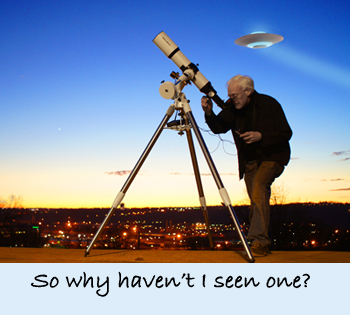
Then there are Sprites, dancing lights that have appeared above most thunderstorms throughout history. Lightning from the thunderstorm excites the electric field above, producing a flash of light called a sprite. Sprites can take the form of fast-paced balls of electricity, streaks or tendrils. Fiery balls have been videotaped 35 to 80 miles high, moving up and down at one-tenth the speed of light. Both jetliner pilots and astronauts have previously reported sightings of sprites, along with a different but equally mysterious phenomenon known as blue jets.
Years of searching and millions of dollars spent seeking evidence of life in the universe by looking for some signature of its technology (spanning all wavelengths from radio to visible light) have yet to turn up a single, non-random signal or transmission.
| These two photos show red sprites associated with thunderstorms and (below) a halo cloud formation. Flying saucers? I don't think meteorologists would agree. | |
| How many commericial airplane pilots have studied rare atmospheric phenomenon and know exactly what they are seeing? Much easier to just report a disc of light that seemed to follow the plane. | 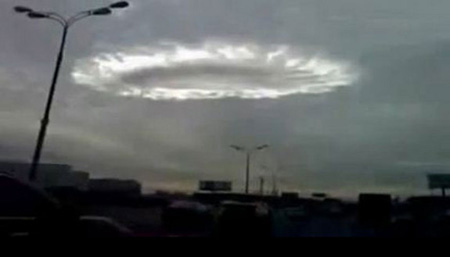 |
We live in an era of Fake News! Fake videos appear daily on the internet. Strange objects in the sky is one of the favorites.
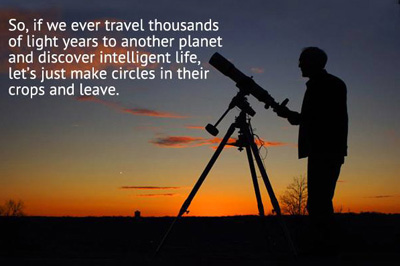 Finally, it's completely pointless to attempt to reason or argue with people who believe in flying saucers because, as psychologists tell us, many people believe things for emotional, not intellectual reasons. They simply have a deep-seated need to believe, a need that can never be influenced by logic or reason.
Finally, it's completely pointless to attempt to reason or argue with people who believe in flying saucers because, as psychologists tell us, many people believe things for emotional, not intellectual reasons. They simply have a deep-seated need to believe, a need that can never be influenced by logic or reason.
Besides the vast distances between stars, what makes an alien visit improbable? Most star systems are binary, consisting of two stars held together by gravitational force. Up to 85% of stars are in binary systems with some in triple or even higher-multiple systems. A planet with multiple suns would never experience enough darkness to see other stars. There are literally billions of star systems that fall into this category. If the inhabitants of a far off planet were completely unaware of other stars and planets, why would they ever make any attempt at space travel or at attempts to communicate across space?
 Of the millions of planets and civilizations that are probably out there, how many have developed an advanced technology without destroying themselves in the process (as we have nearly done)?
Of the millions of planets and civilizations that are probably out there, how many have developed an advanced technology without destroying themselves in the process (as we have nearly done)?
Finally, if that one in a billion civilization manages to travel faster than light and discovers our little blue planet, why in the world would they want anything to do with a comparatively primitive, warlike culture?
Carl Sagan wisely pointed out that extraordinary claims require extraordinary evidence. Fuzzy videos and personal narratives, as engaging as they may be, are simply not enough to support such extraordinary claims. It’s important to keep an open mind about atmospheric anomalies, and not insist that alien spacecraft is the only explanation.
Personally, I'm still waiting to hear "Klaatu Barata Nikto".
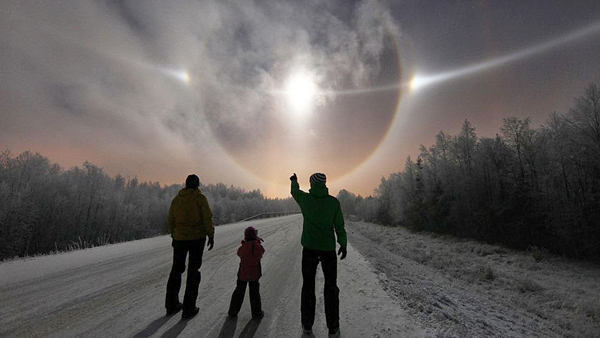
Photos by Pauli Hänninen. These are sun halos or 22 degree halos, which are produced by the ice crystals in cirrostratus clouds. The crystals bend direct sunlight, projecting it elsewhere into the sky, and at a certain angle -22 degrees – a halo can be seen around the sun.
Paul described that night in his village in Finland, “It was cold and very foggy, the temperature was around minus 10 degrees Celsius. When the clouds began to break, there were rainbow colors in the sky and a halo spanning 360 degrees! It was worth taking a picture or two.”
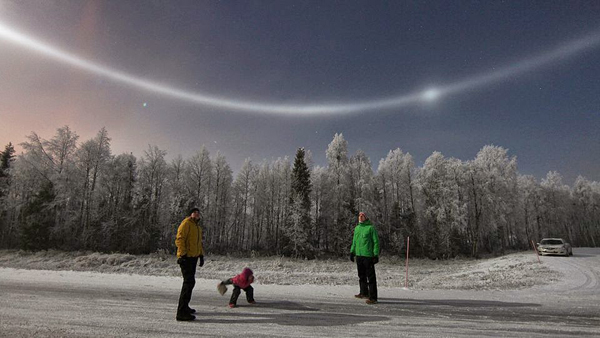
The spots on either side are called sundogs. Sundogs may appear as a colored patch of light to the left or right of the sun, 22° distant and at the same distance above the horizon as the sun, and in ice halos. They can be seen anywhere in the world during any season, but they are not always obvious or bright. Sundogs are best seen and are most conspicuous when the sun is low.
If you want to learn more about unusual atmospheric phenomenon, here are some excellent sources:
Rainbows, Halos & GloriesBy Robert Greenler (1989) CUP
ISBN 0521388651
Seeing the Sky
By Fred Schaaf (1990) John Wiley ISBN
047151067X
The Nature of Light & Colour in the Open Air
By M/Minneart (1954) Dover
ISBN 486201961
Wonders of the Sky
By Fred Schaaf (1983) Dover
ISBN 0486244024
Light from the Sky
(Scientific American articles by various authors)
Freeman & Co
ISBN 0716712229